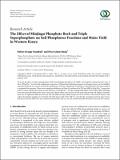| dc.description.abstract | We tested the effects of triple superphosphate (TSP) and Minjingu phosphate rock (MPR), when applied at phosphorus (P) rates of 50 or 250 kg P ha−1 in a factorial combination with urea or Tithonia diversifolia green manure as nitrogen sources, on P availability and maize yields for two seasons at Nyabeda and Khwisero in Kenya. Phosphorus availability was determined by the Olsen method or sequential fractionation. There was no significant difference in Olsen P as influenced by TSP and MPR at 50 kg P ha−1 irrespective of the N source at both sites in both seasons. However, at 250 kg P ha−1, TSP gave significantly higher Olsen P than MPR. The labile P fractions generally followed the same trend as the Olsen P. Maize yields increased with increasing amount of P applied. Generally, there was no significant difference between TSP and MPR on maize yields irrespective of the N source. The Olsen-P, Resin-P, and sodium bicarbonate inorganic P correlated well with maize yields when TSP was used but the correlations between these P tests and maize yields for MPR were not consistent and therefore their use on soils treated with MPR should be exercised with caution. | en_US |

